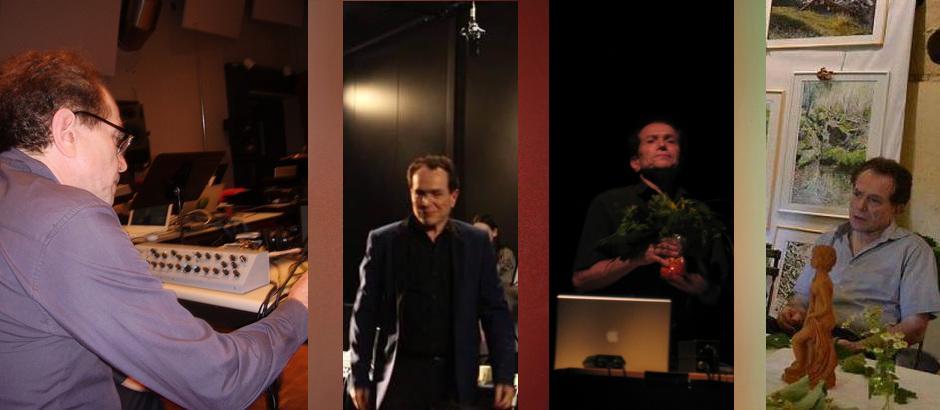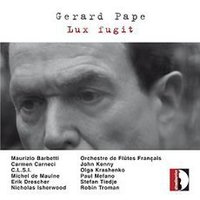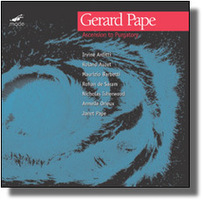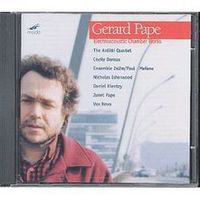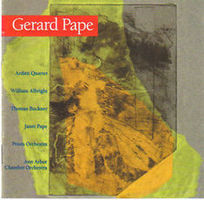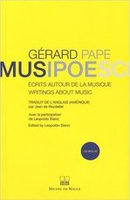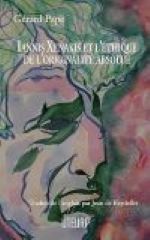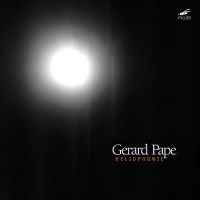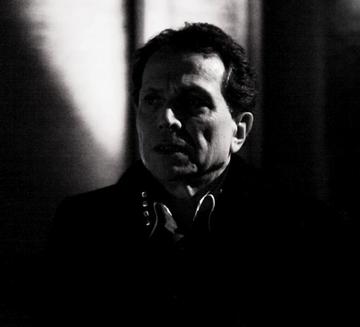
American composer, born in New York City in 1955, has lived in France since 1991. He studied composition privately with George Cacioppo and William Albright and electronic music with George Wilson at the University of Michigan. He has composed more than 80 works for orchestra, chamber ensemble, vocal and instrumental soloists, and electroacoustic works. His works have been played through out the world, including by such reknown performers as Arditti String Quartet, Voxnova, Ensemble 2e2m (conducted by Paul Mefano), Nicholas Isherwood, Erik Drescher, Irvine Arditti, Rohan de Saram, Maurizio Barbetti, Roland Auzet, Neue Vocalsolisten, Orchestre Nationale de Lille (conducted by Jean Claude Casadesus), the Orchestre de Flûtes Français, Estonian National Symphony Orchestra (conducted by Risto Joost) and the Ensemble “U”.
Formerly director of the Ateliers UPIC/CCMIX from 1991 to 2007, Gerard Pape founded the C.L.S.I. (“Cercle pour la Liberation du Son et de l’Image”), an ensemble consisting of 8 performers playing instruments and laptop computers “live” in 2007. In 2010, Pape founded along with his wife, the Russian composer, Olga Krashenko, the D.L.S.I., a duo wherein each composer participates in the performance of the other’s works. A bi-lingual book of 15 of his music texts called “MusiPoéSci”, with contributions by the musicologist Leopoldo Siano and the musicologist/composer Lissa Meridan, will also includes a CD by Mode Records of his recent compositions was published in France by Editions Michel de Maule(Paris) in co-production with Mode Records in March 2015. Recent musical compositions included on the Mode CD are HARMONIES OF TIME AND TIMBRE (2010-2012) for solo flute, 4 violins, 4 cellos and 8 channel tape and HARMONIES OF FORM AND TIME (2011-2012) for six soloists and six chamber orchestras.
Wikipedia, CLSI, Mode Records,
IMSLP.
Donaueschinger Musiktage, Xenakis, Upic, Continuum - Mode Records, Sax Upic - Nova Musica, ALIVE - Ensemble U:
Musicians about Gerard Pape and his music
MusikTexte, Le Monde de la Musique, KFJC On-Line Reviews, Interview with Gerard Pape by Giorgos Frangiskos
Music of Gerard Pape 1993 - 2024
All details of his music on: https://imslp.org/wiki/List_of_works_by_Gerard_Pape
| 2 0 1 8 - 2 0 2 3 : 6 Spectral Etudes | Links | |||
|---|---|---|---|---|
| "6 Spectral Etudes", for piano | ~30' | IMSLP | ||
| 2 0 1 8 : 5 Chants de l'Amour and Being Beauteous | Links | |||
|
"5 Chants de l'Amour", for soprano playing violin, viola, cello (poetry by François Rannou)
"Being Beauteous", coloratura soprano, piano; also version for reciter and glissando flute (poetry by Rimbaud) |
~25' | IMSLP | ~14' | IMSLP |
| 2 0 1 6 - 2 0 2 3 WATT | Links | |||
| "WATT", for tape | ~6' | IMSLP | ||
| 2 0 1 6 - 2 0 2 2 Textures Turbulentes, Formes Emergentes | Links | |||
| "Textures Turbulentes, Formes Emergentes", for amplified string quartet, 8-track tape | ~15' | Youtube | ||
| 2 0 1 6 - 2 0 1 7 Vers la lumière II/III | Links | |||
| "Vers la lumière", for 8-track tape. | ~16' | IMSLP-Vers la lumière II | ~7' | IMSLP-Vers la lumière III |
| 2 0 1 5 Solo music | Links | |||
| "Per Dario", a new solo composition for one of the most complex microtonal keyboards, the Megaplex, including a "live electronics" program which was specially developed for this piece. | ~8' | Soundcloud | ||
| 2 0 1 3 - 2 0 1 4 Opera "POURQUOI DES POETES?" | ||||
|
POURQUOI DES POETES ? (WHY POETS ?) is the first opera from my four opera-cycle-in-progress SUNSET TIME. In this opera, the poet (Hölderlin) and the philosopher (Heidegger) speak of our time as the time of the ʻevening of the worldʼ. Things have reached such a state in our world that we don’t even realize what we have lost. All seems normal to us, even excellent, in our time of great technological progress. We are headed towards a spiritual and cultural abyss and we don’t even know it. Therefore, it is the task of the poet to explore the abyss, to tell the others what it is and how it might be overcome.
Especially developed for this opera is my “halo harmony live electronics”. The goal, thanks to these innovative live electronics, developed in collaboration with Carl Faia at Art Zoyd Studios — commissioners of the work — is to be able to shape the macro-form of the opera’s composition by literally acting upon the sound environment that encloses a live theatrical performance. By creating a variable virtual space-time-timbre as a “halo” around the live performers, the hope is that the public will have an enriched experience of the music via these halo-harmony live electronics that do not just decorate the surface of the music, but which extend the music into the depths of the space-time wherein the public experiences the “live” performance.
|
~60' | |||
| 2 0 1 1 - 2 0 1 2 Orchestra music | Links | |||
| "Harmonies of Form and Time" for six instrumental soloists and 6 chamber orchestras | ~10' | CD Mode Records | ||
| 2 0 1 0 - 2 0 1 2 Chamber music | Links | |||
|
This piece is the first in which I have found a way to "harmonize" time and timbre in music. My new harmony does not restrict itself to be a combination of frequencies and timbre colours; rather, it's the movement within the sound itself which makes this sound based harmony dynamic. Timbres that pulse and vibrate in time in non-rigid ways create complex sound combinations that "harmonize" due to spectral relations between the fundamental frequencies and their partials. However, unlike the spectral music in the past, frequencies are not fixed, and sound continuously transforms in timbre and time.
|
~60' | CD Mode Records | ||
| 2 0 0 9 Chamber music | Links | |||
| "Harmonies of Space and Time" for 3 acoustical spaces, 3 stereo tapes and reciter’s voice «live». Text of Gerard Pape «99 propositions with regard to space after the Divine Comedy of Dante» | ~99' | |||
| "On court à la catastrophe..." for viola, saxophone and piano | ||||
|
This piece is written in memory of the great composer Luigi Nono. The first performance has taken two years to arrange because of the very difficult flute and string writing that requires new instrumental techniques developed in close collaboration involving intensive research between composer and performers. I wish to thank Erik Drescher and Olga Krashenko for taking the time to work with me to find solutions for instrumental writing that other performers have deemed either impossible or too time consuming as to be practical. The model of the « suoni mobili » (mobile sound) that Nono gave us was developed by him in collaboration with courageous performers who like Nono himself wanted to find new ways to transform and explore sound itself as primary compositional material. My work is written in that spirit as a voyage into the heart of time and timbre.
|
~9' | CD Stradivarius | ||
| 2 0 0 8 Solo and electronic music | Links | |||
|
This graphic score uses the same macro-form as my electronic tape composition Heliophonie I. The piece represents sonically the birth, life and death of the Sun. The graphics are meant to be interpreted literally and precise indications are given in the score as to frequency ranges within which 8 computers are each suppose to play as well as exact time indications as to when they are suppose to play which events. The graphic score notation is inspired by my work with Xenakis's UPIC system and one can say that the music in the score represents, like the UPIC does, the image of the sound rather than the sound of the image.
|
~50' | CD Stradivarius | ||
|
The piece was composed following the death of Karlheinz Stockhausen the fourth of December 2007. In the days that followed my shock and sadness after having learned of his rather unexpected passing, I first wrote the poem "Licht und Klang" and then decided to set my poem to music. You will find here after the poem which is my very personal response to the death of a man who was not only one of the greatest composers of the 20th century but who was also someone who was a great source of inspiration for me personally as a composer.
|
~8' | CD Stradivarius | ||
| 2 0 0 7 Chamber and electronic music | Links | |||
| "Against Numbers" for soprano voice and percussion | ||||
| "Incantatrix" for soprano voice and ensemble. Text of Clive Barker and Kurt Carpenter | ||||
|
Noirval was written in the month of July 2007. The piece was written for bass voice solo and 9 bass flutes. Why did I choose these timbre colours so somber, so black? The work is a portrait in sound of the very great poet Gerard Nerval. The bass voice sings a poem that is very emblematic of Nerval, "El Desdichado", the first poem of his great cycle "Les Chimeres".Nerval was a very great poet, but he suffered terribly from melancholia, also known as psychotic depression.
|
~8' | CD Stradivarius | ||
| "Faux mouvements" for stereo tape | ||||
| 2 0 0 6 Chamber and electronic music | Links | |||
| "Héliophonie" for 8 channel tape | ~50' | Youtube | ||
| "2 Chimères" for soprano voice, reciter, recorder, flute. Poetry of Gérard de Nerval | ~8' | CD Stradivarius | ||
| 2 0 0 5 Solo and electronic music | Links | |||
| "Funeral Music" (hommage to Mozart) for stereo tape | ||||
| "Lux Fugit" (in Memoriam Luc Ferrari) for viola solo | ~13' | CD Stradivarius | ||
| 2 0 0 4 Solo music | Links | |||
| "3 Quantic Etudes" for contrabass solo | ||||
| "Ascension to Purgatory" for percussion solo | ||||
| 2 0 0 3 Solo music | Links | |||
|
"For Maurizio", commissioned by and dedicated to the Italian violist, Maurizio Barbetti, is the first piece in which I explore temporal flow in composition as deriving, not from fixed durations that are a result of subdivisions of a steady beat , but rather that are a consequence of composing with continuously speeding up and slowing down scales of speed, ,that is, metronomic tempo pulsations that regulate the speed of pulsating/oscillating sound elements. Tempo, or beat, in the traditional sense, is only used to give measures a fixed length, but without the metrical implications of traditional metered music. Measure lengths are fixed so as to control proportional relations on a formal level, but within a measure, individual sound event durations are relative to the scales of pulsation speeds and density distribution patterns. This rather short work of 3'30" is written in 16ths of tones so as to explore micro-oscillation of pitch as it varies between vibrato and micro-tonal pitch pattern, depending on the speed and depth of oscillations and pulsations that control it. Continua of intensity and timbre also modulate sound events relative to durations that are themselves relative to the scales of oscillation and pulsation that govern the micro-temporality of this work.
|
~4' | |||
| 2 0 0 2 Solo music | Links | |||
|
The title of this piece in French means the "birth of sound." It is dedicated "In Memoriam Iannis Xenakis". In this work, sound is born from rhythm and time. The piece starts with gradually accelerating pulsations of un-pitched noise. Only over the whole work are the other aspects of sound introduced: timbre, intensity, pitch. The birth of sound requires time. In this piece, time, or tempo, is speeding up and slowing down all the way through. There is no constant tempo, meter, or measure length. Sometimes a very rapid rhythm is happening in a very short duration. This is physically when rhythm starts to turn into continuous sound. As the piece goes on, the durations of the measures are getting longer and longer as time (tempo) is slowing down. There is one measure, for example, that lasts one minute towards the end. Paradoxically, even though time is slowing down, the density of rhythmic activity is no less. It is as though we are putting a microscope on the inner life of the sound and we are hearing in slow motion rhythms that are normally too fast to hear. For example, in the last section of the piece, we hear slowly oscillating micro-tonal pitch/intensity patterns (micro-detuned double stops in sixteenths of tones with variable accentuations) that represent what timbres, or waveforms, really are: rhythmical oscillations of extremely rapid micro-intensity variations that we hear as continuous sound that has a resultant timbre / intensity, with sometimes a steady pitch, as well. Thus, time links rhythm together with pitch, timbre and intensity, which together make up sound. Pulsations inside the sound create cycles of rhythm. Rhythmic cycles of pitch, intensity and timbre, as a function of time, allows sound to be born."La Naissance du Son" was commissioned by the Texas Eye and Ear Festival and premiered in that festival in Austin, Texas in September 2002 by Rohan de Saram within a Pape monographic concert played by the Arditti String Quartet.
|
~4' | Soundcloud | ||
| 2 0 0 1 Chamber music | Links | |||
| "The Ecstasy of St. Theresa" (hommage to Bernini) for 9 mixed voices. Text by St. Theresa of Avila, adapted by Gerard Pape | ||||
| 2 0 0 0 Opera "LES CENCI", electronic music | Links | |||
| "Tantric Transformations" for 8 channel tape | ||||
| Opera "Les Cenci" for 7 vocal soloists, orchestra of 24 flutes, 3 percussionists, mixed choir and live electronics (work in progress). Opera in 3 acts, based on the play by Antonin Artaud | ||||
| 1 9 9 9 Solo and electronic music | Links | |||
| "Fabula" for 8 channel tape | ||||
| "Aquarelles" for basset horn doubling 1/2 clarinet | ||||
| "Mon Autre Peau" for 20 channel tape. Texts by Ana-Paula Portilla, Parmenides, and the Upanishads | ||||
| 1 9 9 8 Chamber music, opera "WEAVEWORLD | Links | |||
| "Makbénach IV" for trombone and live electronics | ~10' | CD Stradivarius | ||
| "Funeral Sentences" for two soprano voices and a percussionist | ||||
|
This prologue is an excerpt from my opera, "Weaveworld" which remains a "work in progress". In the "Prologue", Gluck, sung here by Nicholas Isherwood, announces the theme of the opera: the idea of little worlds within big worlds, little loops of time within big loops. Despite the fractal quality of the world and of time, nothing is fixed. Thus, the music of the "Prologue" is a mirror image of these ideas. Like much of my music, this is chaotic music of great density where small changes of pitch, intensity and timbre happen within cycles of time that are small and large at the same time. This is very slow, yet very active music, nonetheless.
|
||||
| 1 9 9 7 Orchestra music | Links | |||
| "Feu Toujours Vivant" for large orchestra and 8 channel tape | ||||
| 1 9 9 6 Chamber music, opera "WEAVEWORLD" | Links | |||
|
Battle is a dramatic musical scene taken from Weaveworld, famous novel of Clive Barker written in 1987. The general idea of this dramatic scene is the struggle to reconcile discontinuity and continuity, disorder and order. It is not a question of one destroying the other but of their co-existence at the end of the piece in the form of chaos, a structure that is at the same time orderly and disorderly. The macro-form of this piece was inspired by the scientific studies of the passage from order to disorder to chaos in nature (Period 3 implies Chaos). In the novel, Immacolata (the black Madonna), Shadwell (the evil salesman who aids her) and the Byblows (the monstrous children of Immacolata's sister) represent the forces of discontinuity, disorder, hate and materialism who wish to destroy the Weaveworld. On the other hand, the Seerkind (supernatural entities with magic powers taken from the Garden of Eden), Suzanna and her lover Cal (the guardians of the living carpet, Weaveworld, where the Seerkind hide) represent the forces of continuity, order, love and imagination. In Battle, Cal sings three times a hymn to love and imagination: "Though life itself is but a wilderness of dust, the love true lovers imagine need never be lost." Battle is orchestrated for 4 solo voices: Suzanna (lyric soprano), Cal (tenor), Shadwell (bass), Immacolata (coloratura) and two mixed choirs (Seerkind and Byblows). The two choirs have been pre-recorded and spatialized onto multi-channel tape. The macro-form of the piece is broken into 14 short sequences where the two antithetical worlds confront each other in sound before the climactic 15th sequence, which terminates in their co-existence in the form of chaos. Battle was commissioned by Nicholas Isherwood and his ensemble VoxNova with the financial aid of the CNAT (National Center for Art and Technology) of the city of Reims. It is dedicated to Nicholas Isherwood and to VoxNova.
|
~8' | CD Mode Records | ||
|
The work was written for, and admirably performed by, saxophonist Daniel Kientzy and the Ensemble 2e2m under the direction of Paul Mefano. The saxophone part often utilizes wide and erratic vibrato, sounding at times like Greek or Balkan music, and at other times like Albert Ayler. Like the other works, this one was composed according to the principles of multiparametric polyphony. The tape part consists of instrumental and synthetic sounds convolved and mixed with a voice.
|
~10' | CD Mode Records | ||
| "Makbénach II" for saxophone and ensemble | ||||
| "Makbénach III" for saxophone and 8 channel tape | ||||
| 1 9 9 5 Opera "MONOLOGUE" | Links | |||
|
Although over 32 mm in duration, this work never seems to lose focus. First, there is a vast display of vocal techniques, from the most nasal to the most full-throated. Virtuoso bass Nicholas Isherwood manages to comfortably vary the pitch, intensity, and timbre of his voice, at times producing deep, Tibetan-like growling in rapid succession with very high-pitched nasal whining. Mr. Pape describes this piece as a chamber opera for bass voice and eight-channel tape. The tape part was composed on the UPIC system.
|
~32' | CD Mode Records | ||
| 1 9 9 4 Solo, chamber and electronic music | Links | |||
| "Le Fleuve du Désir I" (string quartet #3) | ||||
| "Le Fleuve du Désir II" for UPIC-generated stereo tape | ||||
|
Le Fleuve du Desir (River of desire), for string quartet and tape, was inspired by the composer's contemplation of fluid flow, both real and imaginary. He uses eight trajectory rates to control changes of pitch, vibrato, amplitude, and bow accentuation, position, color, speed, and pressure. Texturally the piece moves between harmonic series, clusters and noise. The effect is remarkable, and includes human-like sounds such as crying, soft wailing, and speech, all performed by the strings. At times, the eight trajectories contribute to an exaggerated, artificial-sounding texture that threatens to erupt into total chaos. The members of the Arditti String Quartet heard on this recording live up to their customary excellence. One gets the impression that the title refers not to an amorous desire, but instead to a desire which seeks to extract itself from a larger, turbulent context that has imprisoned it.
|
~12' | CD Mode Records | ||
| "Le Fleuve du Désir IV" for violin and 8 channel tape | ||||
| "Le Fleuve du Désir V" for violin and 8 channel tape | ||||
| "Le Fleuve du Désir VI" for viola and 8 channel tape | ||||
| "Le Fleuve du Désir VII" for cello and 8 channel tape | ||||
| "Le Fleuve du Désir VIII" for double bass and 8 channel tape | ||||
| 1 9 9 3 Electro-acoustic music | Links | |||
|
Two Electro-Acoustic Songs, the earliest, is scored for voice, flute, tape, and sound projection. It combines flute attacks with vocal sustains, and vice versa, resulting in an elaborate "timbral monophony." Though it is perhaps the most con-ventional sounding work,of the five, the sheer display of timbral/harmonic combinations is more than enough to sustain interest. The texts for the songs come from two poems by the Israeli poetess, Dahlia Ravikovitch, and are set in the original Hebrew. In the second song, On the Road at Night, the UPIC is used to both clarify and cloud the harmonic content of the voice and flute parts.
|
~10' | CD Mode Records |

